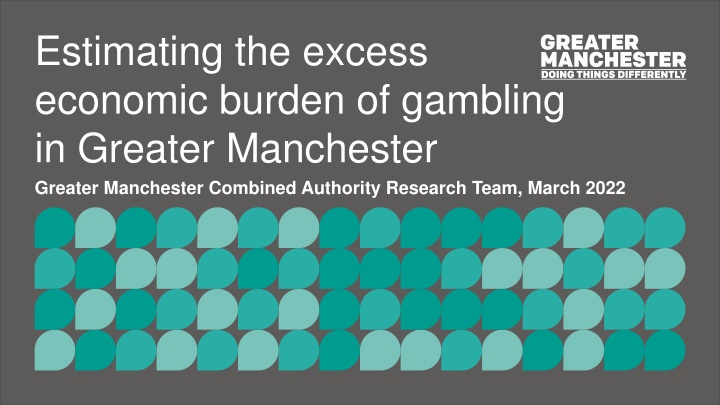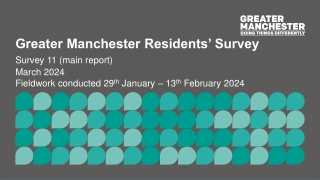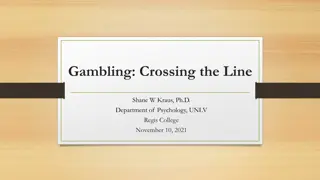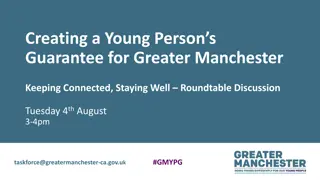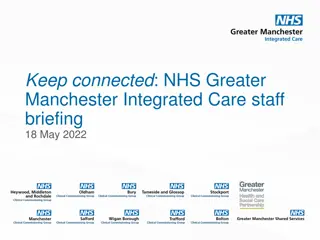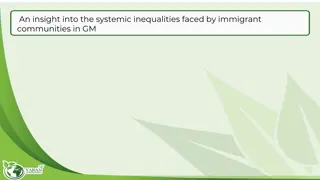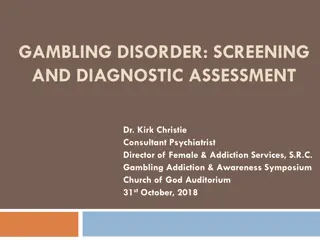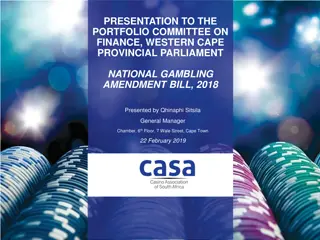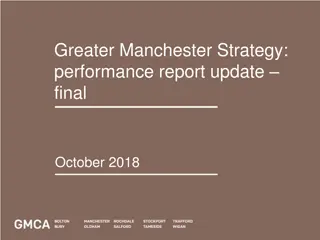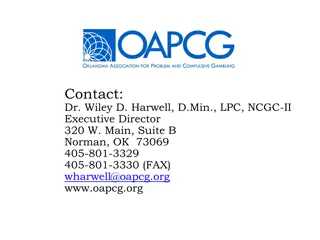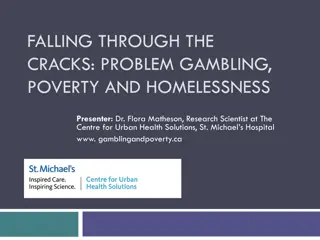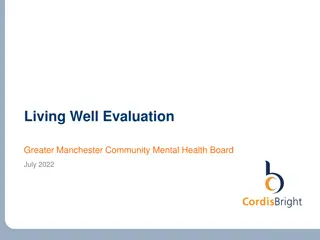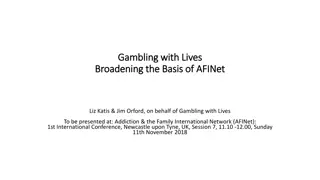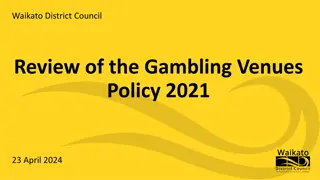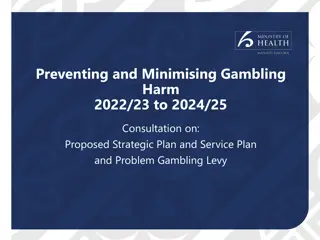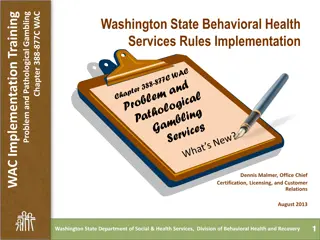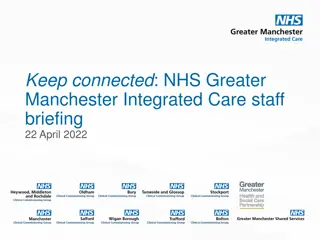Economic Burden of Gambling in Greater Manchester 2022
Economic analysis reveals the estimated excess economic burden of gambling in Greater Manchester in 2022 is at least £80m, encompassing direct costs to the public purse and societal costs. The harms include treatment for depression, imprisonment, unemployment benefits, statutory homelessness, alcohol dependence treatment, and illicit drug use. The total excess costs are broken down across various domains and sub-domains, reflecting tangible and intangible impacts. The report emphasizes that these figures likely underestimate the full scope of harms associated with problem gambling.
Download Presentation

Please find below an Image/Link to download the presentation.
The content on the website is provided AS IS for your information and personal use only. It may not be sold, licensed, or shared on other websites without obtaining consent from the author.If you encounter any issues during the download, it is possible that the publisher has removed the file from their server.
You are allowed to download the files provided on this website for personal or commercial use, subject to the condition that they are used lawfully. All files are the property of their respective owners.
The content on the website is provided AS IS for your information and personal use only. It may not be sold, licensed, or shared on other websites without obtaining consent from the author.
E N D
Presentation Transcript
Estimating the excess economic burden of gambling in Greater Manchester Greater Manchester Combined Authority Research Team, March 2022
Executive Summary (1/3) Economic analysis of the harms associated with problem gambling in Greater Manchester suggests that the estimated excess economic burden of gambling across the city region in 2022 is at least 80m. As with the national estimates included in the PHE Gambling Evidence Review, this is likely to be an underestimate, as some harms have only been partially costed and others not at all. This 80m comprises 46m in direct costs (fiscal costs to the public purse) plus 33m in further societal costs (less tangible impacts reflecting instances of premature deaths associated with gambling). Direct costs relate to a range of harms: treatment for depression; imprisonment; unemployment benefit claims; statutory homelessness; treatment for alcohol dependence; and illicit drug use. Estimating the excess economic burden of gambling in Greater Manchester
Executive Summary (2/3) Domain Sub-domain Cohort Fiscal Costs Wider (economic / social) costs Total Financial Statutory homelessness Adults 4,200,000 4,200,000 Health Deaths from suicide Adults 33,400,000 33,400,000 Health Depression Adults 23,900,000 23,900,000 Health Alcohol dependence Adults 400,000 400,000 Health Illicit drug use 17-24 years 200,000 200,000 Employment and education Unemployment benefits Adults 6,000,000 6,000,000 Criminal activity Imprisonment Adults 11,400,000 11,400,000 All modelled excess costs 46,100,000 33,400,000 79,500,000 Costings related to homelessness, depression, alcohol dependence and illicit drug use reflect harms experienced by at risk (4.3%) and problem gamblers (0.7%). Costings related to suicide, unemployment and imprisonment relate only to problem gamblers. Estimating the excess economic burden of gambling in Greater Manchester
Executive Summary (3/3) Estimated excess economic burden of gambling in Greater Manchester in 2022 Treatment for illicit drug use (direct costs) 200,000 Treatment for alcohol dependency (direct costs) 400,000 Statutory homelessness (direct costs) 4,200,000 Unemployment benefits claims (direct costs) 6,000,000 Imprisonment (direct costs) 11,400,000 Treatment for depression (direct costs) 23,900,000 Deaths from suicide (intangible costs) 33,400,000 Estimating the excess economic burden of gambling in Greater Manchester
Part 1 Introduction Estimating the excess economic burden of gambling in Greater Manchester
Introduction (1/2) This presentation provides an overview of bespoke analysis undertaken by the GMCA Research Team to estimate the current economic and social costs of harms associated with gambling in Greater Manchester. The analysis closely follows the approach to estimating costs that was included in Public Health England s evidence review on gambling related harms, published in November 2021. As such, it provides a cost estimate that focuses on the harms associated with both at risk and problem gambling, which in Greater Manchester encompasses a cohort making up an estimated 5% of the resident population. Part 1. Introduction
Introduction (2/2) In mirroring the PHE methodology, the approach to costing uses the best- available evidence on prevalence, harms and costs. Bespoke feature of the local modelling include: (i) use of a robust and bespoke local estimate of at risk and problem gambling in GM, generated from results in the Heath Survey for England; (ii) an approximation of GM shares of national cost estimates that reflects both the size of the GM population and local levels of need/harm where available; and (iii) use of cost estimates that are uprated to current prices (all either PHE estimates, or Treasury-endorsed unit cost assumptions within the GMCA Unit Cost Database). Part 1. Introduction
Part 2 Methodology Estimating the excess economic burden of gambling in Greater Manchester
Methodology (1/2) The GMCA analysis took as its starting point the PHE Gambling-related harms evidence review: the economic and social cost of harms, published in September 2021 and available online here. This means that the GM estimates have to carry the same caveats and notes as the national research, for example: Estimates are conservative, and likely to be an underestimate of the true costs of harmful gambling; and The costing includes some, but only a small proportion, of the metrics suggested in Wardle et al s suggested framework for understanding and measuring a full breadth of gambling-related harms (which can be experienced by individuals, families and communities) see slide 8 for a visualisation of this (highlighted elements are within he scope of the analysis). PHE s cost analysis was restricted to those areas where evidence of harm and associated costs is currently strongest. All costs reflect an estimate of the excess economic burden of gambling this considers the increased odds of costs arising in populations where at risk or problem gambling is present, vs costs in the wider/general population. The national analysis from PHE estimates that the excess economic burden of gambling in England in 2019/20 was 1.27 billion. This comprises 647m direct costs (fiscal costs, those impacting upon the public purse) and a further 619m intangible costs (societal cost of the estimated number of lives lost due to suicide associated with gambling) Part 2. Methodology
Methodology (2/2) One simple way of estimating the equivalent economic burden of gambling in Greater Manchester would be to assume, all things being equal, that 5% of the national burden falls within GM (pro-rated to resident population). This would assume an overall excess cost of 64m. Instead, the GM analysis has been undertaken with a view to refining this headline assumption in three key ways: 1.The analysis is based on an estimate of the prevalence of at risk and problem gambling within GM (higher than the standard national prevalence assumption). This was calculated by national experts in the field, on behalf of the GMCA. 2.The analysis uses whatever information is available in published sources on levels of demand in the GM system in key areas e.g prevalence of depression amongst GM residents; levels of crime in GM. These figures are generally higher than is the case across England. 3.The analysis uprates assumed costings to reflect 2021/22 prices (the PHE analysis, whilst very recently published, is still based on 2019/20 cost assumptions). The intention of this approach is to preserve the robustness of the national best-in-class analysis, but including bespoke elements that best reflect the latest challenges likely to exist within Greater Manchester. Part 2. Methodology
Scope costs included in the estimate The analysis looks at the evidence of prevalence, harms and costs in respect of the following areas: Statutory homelessness - the annual cost of statutory homeless applications Depression the annual direct healthcare cost of individuals suffering from depression (primary care (GP time), secondary care and prescription costs. Alcohol dependence the cost of community alcohol treatment Illicit drug use the cost of treatment for opioid use Suicide the intangible cost of a life lost Imprisonment the average annual cost of imprisonment per prisoner Unemployment the cost of an individual being unemployed (typical unemployment spell) Part 2. Methodology
Measuring gambling related harms Whereas the framework provides over 50 metrics of gambling-related harm, Wardle, and others, also propose a simplified model to start with, the Foundation model . This is formed of the areas that currently are likely to have evidence and data, so gambling-related harms can be costed. The areas of the Foundation model are: loss of employment experience of bankruptcy or debt loss of housing or homelessness crime associated with gambling relationship breakdown or problems health-related problems suicide and suicidality Highlighted metrics reflect those included in the national (and hence GM) costing exercise Part 2. Methodology
Part 3 Headline findings Estimating the excess economic burden of gambling in Greater Manchester
Headline findings (1/2) Economic analysis of the harms associated with problem gambling in Greater Manchester suggests that the estimated excess economic burden of gambling across the city region in 2022 is at least 80m. This figure comprises 46m in direct costs plus 33m in further societal costs (reflecting instances of premature deaths associated with gambling). Domain Sub-domain Cohort Fiscal Costs Wider (economic / social) costs Total Financial Statutory homelessness Adults 4,200,000 4,200,000 Health Deaths from suicide Adults 33,400,000 33,400,000 Health Depression Adults 23,900,000 23,900,000 Health Alcohol dependence Adults 400,000 400,000 Health Illicit drug use 17-24 years 200,000 200,000 Employment and education Unemployment benefits Adults 6,000,000 6,000,000 Criminal activity Imprisonment Adults 11,400,000 11,400,000 All modelled excess costs 46,100,000 33,400,000 79,500,000 Part 3. Headline findings
Headline findings (2/2) Estimated excess economic burden of gambling in Greater Manchester in 2022 Treatment for illicit drug use (direct costs) 200,000 Treatment for alcohol dependency (direct costs) 400,000 Statutory homelessness (direct costs) 4,200,000 Unemployment benefits claims (direct costs) 6,000,000 Imprisonment (direct costs) 11,400,000 Treatment for depression (direct costs) 23,900,000 Deaths from suicide (intangible costs) 33,400,000 Part 3. Headline findings
Financial statutory homelessness The average one-off and on-going costs associated with statutory homelessness are 3,020 (2021/22 prices) MHCLG Homelessness data 2020/21 shows that over 6,500 people across Greater Manchester were threatened with homelessness within 56 days and judged to be owed the LA homelessness duty; around 9% higher than would be expected purely based on the population of Greater Manchester. Academic studies in Westminster and elsewhere have calculated a strong, positive association between gambling and access of homeless services e.g. problem gamblers 16 times more likely to access services - these associations are borrowed for the Greater Manchester analysis. Financial modelling takes account of the ~5.0% of the local population who are at risk or problem gamblers across Greater Manchester which is 19% higher than the equivalent figure across England as a whole (~4.2%). Part 3. Headline findings
Health deaths from suicide The discounted intangible unit cost of one suicide is 1,510,000. This is based on an accepted proxy representation of 60,000 per statistical life year, from the HM Treasury Green Book Registered deaths data from the Office of National Statistics shows that there were 1,154 registered suicides of residents of Greater Manchester over the five year period 2016 - 2020 combined*. This is slightly less than would be expected purely based on the population of GM. International academic studies have found that problem gamblers were 19.3 times and 9.6 times more likely to die by suicide compared to the general population in younger (20 to 49 years) and older (50 to 74 years) age groups, respectively these associations are borrowed for the GM analysis. Financial modelling takes account of the ~0.8% of the local population who are problem gamblers across GM which is slightly higher than the equivalent figure across England as a whole (~0.7%) *2020 alone does not appear to have been a representative year for Greater Manchester figures, and so a five year run of statistics was referenced instead Part 3. Headline findings
Health depression The average annual cost of depression is 1,640 (2021/22 prices). This mean cost takes account of healthcare expenditures (primary and secondary care, as well as prescription costs) in relation to patients with conditions. PHE data shows that the prevalence of depression amongst the Greater Manchester adult resident population is 14.3%; around 16% higher than the England figure. One respected academic study found that gambling was associated with increased odds of major depressive disorder (adjusted odds ratio (AOR) 1.98, 95% CI 1.14 and 3.44) - these associations are borrowed for the Greater Manchester analysis. Financial modelling takes account of the ~5.0% of the local population who are at risk or problem gamblers across Greater Manchester which is 19% higher than the equivalent figure across England as a whole (~4.2%) Part 3. Headline findings
Health alcohol dependence MHCLG and NDTMS data on days in community treatment and total expenditure in this area has been used to derive an annual cost per individual receiving alcohol treatment, estimated at 1,300 (2021/22 prices). This does not take account of broader NHS expenditure. PHE data shows that there are an estimated ~38,000 adults across Greater Manchester with alcohol dependence, a rate of dependency 27% higher than the national figure. One respected academic study showed that gambling increased the odds of alcohol dependence 2.2 times (95% CI 1.17 and 4.13) in adults aged 18 to 20 - these associations are borrowed for the Greater Manchester analysis. Financial modelling takes account of the ~5.0% of the local population who are at risk or problem gamblers across Greater Manchester which is 19% higher than the equivalent figure across England as a whole (~4.2%) Part 3. Headline findings
Health illicit drug use MHCLG and NDTMS data on days in community treatment and total expenditure in this area has been used to derive an annual cost per individual receiving drug treatment, estimated at 2,800 (2021/22 prices). This does not take account of broader NHS expenditure. PHE data shows that there were nearly 7,000 NHS hospital finished admission episodes with a primary or secondary diagnosis of drug related mental and behavioural disorders in 2019/20. This represents a demand pressure in the system 42% higher than across the country as a whole. Analysis of the Avon Longitudinal Study for Parents and Children cohort in England has established that a small minority of young adults aged 17 to 24 had a low-risk, moderate-risk or problem gambling associated with subsequent harmful drug use. The adjusted odds ratio for illicit drug use indicated 1.49 (95% CI 1.07 and 2.06) times increase for younger adults (aged 17 to 24) who were low-risk gamblers and a 1.95 (95% CI 1.06 and 3.61) times increase for younger adults (aged 17 to 24) who were moderate-risk or problem gamblers. Financial modelling takes account of the ~5.0% of the local population who are at risk or problem gamblers across Greater Manchester which is 19% higher than the equivalent figure across England as a whole (~4.2%). Part 3. Headline findings
Employment and education unemployment The government (or fiscal) annual cost of an individual being unemployed is estimated to be 13,641. DWP figures on the number of people claiming unemployment related benefits (Alternative Claimant Count data) suggests that there were approx. 70,000 claimants in the years leading up the pandemic (and then, at times since, substantially more). Greater Manchester figures are higher than would be expected based purely on local population size (claimants typically comprise around 6.5% of all claimants across England). IPPR s analysis for the Cards on the Table cost analysis found that being a problem gambler was associated with being 2.65 times more likely to be claiming Jobseeker s Allowance (JSA) compared with non-problem gamblers. Financial modelling takes account of the ~0.8% of the local population who are problem gamblers across GM which is slightly higher than the equivalent figure across England as a whole (~0.7%). Part 3. Headline findings
Criminal activity imprisonment Her Majesty s Prison and Probation Service compiles unit costs per prisoner on an annual basis. In 2019, this was estimated to be 41,136 per prisoner. This analysis uses an uprated figure of 44,298 per prisoner (2021/22 prices) Home Office data on police recorded crime by offence group and police force area, year ending September 2020, shows that total recorded crime in Greater Manchester made up 6% of the England total (higher than the 5% that would be expected purely based on resident population. This disproportionality was more marked still for some serious offences. Recorded crime statistics were used in this analysis in light of the difficulty accessing data on prison populations cut by local authority of residence. A range of international studies have consistently found that there is a higher proportion of individuals who are classified as problem gamblers in prison populations than there are in the non-prison population. Financial modelling takes account of the ~0.8% of the local population who are problem gamblers across Greater Manchester which is slightly higher than the equivalent figure across England as a whole (~0.7%). Part 3. Headline findings
Part 4 Conclusions Estimating the excess economic burden of gambling in Greater Manchester
Conclusions (1/2) This analysis is grounded in the PHE Gambling Evidence Review methodology, and so many of the observations already made about that study would apply here. Most notably, the estimated excess cost should be considered a conservative figure given it is based on what are described as available but incomplete metrics . Authors of the PHE study have concluded that many data limitations remain, and in some respects we still have to contend with a scarce evidence base to identify the harms caused by gambling-related behaviour . The 46m current direct costs attributed in this analysis to Greater Manchester s at risk and problem gamblers is a figure that is being associated with the cost-consequences of gambling of ~113,000 people living in the city region. However, it is important to bear in mind that these costs will be substantially concentrated in the public service response to Greater Manchester s ~16,000 problem gamblers -- those individuals for whom gambling represents a clinical issue, and where individuals will be typically gambling to an extent that compromises, disrupts or damages their personal and wider family life. Part 4. Conclusions
Conclusions (2/2) The broader 80m figure incorporates a recognition of the wider societal harms of gambling. No cost analysis can adequately convey the impact of lives lost as a result of gambling, which is more appropriately captured through qualitative methods and the testimony of those with lived experience of gambling harms, but this broader figure is an important alternative figure offered by the analysis and should be taken as one small, but important, way to reflect the broader impact of harmful gambling in the city region. Greater Manchester s ability to estimate prevalence through careful analysis of the Health Survey for England has significantly strengthened this cost analysis. It represents one significant, bespoke element of the GM analysis, which is a first attempt to estimate local impacts with due regard to the best national evidence, but also local circumstance. Work in this area in the future should tap into the ongoing programme of work on gambling harm reduction, and also reflect on new evidence from academia as it becomes available. Part 4. Conclusions
Part 5 Glossary and references Estimating the excess economic burden of gambling in Greater Manchester
Glossary of terms Direct costs often referred to as fiscal costs in cost benefit analysis, these are costs to the public purse, i.e. costs to government or other public agencies such as local authorities, the NHS or the police. Intangible costs sometimes referred to as wider societal costs, these are the non-fiscal costs that are often included in cost benefit analysis to express in monetary terms the broader impacts of harms and problems on society as a whole. These can be economic (e.g. impacting on an individual s productivity or lifetime earnings) or societal (e.g. reflecting lives lost, or quality of life changes), the latter of which is prominent in health economics. Problem gambling / gambler(s) a clinical issue where a person gambles to an extent that compromises, disrupts or damages family, personal or recreational pursuits. Problem gamblers score 8 or more on the PGSI. At risk gambling / gambler(s) at risk gamblers are typically low- or moderate-risk gamblers, meaning they may experience some level of negative consequences due to their gambling. Low-risk gamblers (people scoring between 1 and 2 on the PGSI) experience a low level of problems with few or no identified negative consequences. Moderate-risk gambling (people scoring between 3 and 7 on the PGSI) experience a moderate level of problems leading to some negative consequences. Problem Gambling Severity Index (PGSI) - a 9-item screening tool used to measure at risk behaviour in problem gambling. Scores range from 0-27, with recognised thresholds in relation to who will be screened as low-risk , moderate-risk and problem gamblers Part 5. Glossary and references
References IPPR (2016) Cards on the table: The cost to government associated with people who are problem gamblers in Britain, IPPR. Available at: https://www.ippr.org/research/publications/cards-on-the-table Public Health England (2021) Gambling-related harms: evidence review; The economic and social cost of harms, GOV.UK. Available at: https://www.gov.uk/government/publications/gambling-related-harms-evidence-review Wardle, H. et al. (2018) Measuring gambling-related harms: A framework for action . Available at: https://www.gamblingcommission.gov.uk/manual/national-strategy-to-reduce-gambling- harms/research-to-inform-action-defining-measuring-and-monitoring-gambling-related Part 5. Glossary and references
Appendix A Locality costings Estimating the excess economic burden of gambling in Greater Manchester
Bolton Domain Sub-domain Cohort Fiscal Costs Wider (economic / social) costs Total Financial Statutory homelessness Adults 350,000 350,000 Health Deaths from suicide Adults 3,940,000 3,940,000 Health Depression Adults 2,330,000 2,330,000 Health Alcohol dependence Adults 40,000 40,000 Health Illicit drug use 17-24 years 20,000 20,000 Employment and education Unemployment benefits Adults 700,000 700,000 Criminal activity Imprisonment Adults 1,100,000 1,100,000 All modelled excess costs 4,540,000 3,940,000 8,480,000 Appendix A locality costings
Bury Domain Sub-domain Cohort Fiscal Costs Wider (economic / social) costs Total Financial Statutory homelessness Adults 50,000 50,000 Health Deaths from suicide Adults 2,200,000 2,200,000 Health Depression Adults 890,000 890,000 Health Alcohol dependence Adults 20,000 20,000 Health Illicit drug use 17-24 years 10,000 10,000 Employment and education Unemployment benefits Adults 400,000 400,000 Criminal activity Imprisonment Adults 800,000 800,000 All modelled excess costs 2,170,000 2,200,000 4,370,000 Appendix A locality costings
Manchester Domain Sub-domain Cohort Fiscal Costs Wider (economic / social) costs Total Financial Statutory homelessness Adults 1,370,000 1,370,000 Health Deaths from suicide Adults 5,710,000 5,710,000 Health Depression Adults 4,390,000 4,390,000 Health Alcohol dependence Adults 90,000 90,000 Health Illicit drug use 17-24 years 40,000 40,000 Employment and education Unemployment benefits Adults 1,500,000 1,500,000 Criminal activity Imprisonment Adults 2,200,000 2,200,000 All modelled excess costs 9,590,000 5,710,000 15,300,000 Appendix A locality costings
Oldham Domain Sub-domain Cohort Fiscal Costs Wider (economic / social) costs Total Financial Statutory homelessness Adults 440,000 440,000 Health Deaths from suicide Adults 2,170,000 2,170,000 Health Depression Adults 1,850,000 1,850,000 Health Alcohol dependence Adults 30,000 30,000 Health Illicit drug use 17-24 years 10,000 10,000 Employment and education Unemployment benefits Adults 600,000 600,000 Criminal activity Imprisonment Adults 900,000 900,000 All modelled excess costs 3,830,000 2,170,000 6,000,000 Appendix A locality costings
Rochdale Domain Sub-domain Cohort Fiscal Costs Wider (economic / social) costs Total Financial Statutory homelessness Adults 400,000 400,000 Health Deaths from suicide Adults 2,610,000 2,610,000 Health Depression Adults 2,410,000 2,410,000 Health Alcohol dependence Adults 30,000 30,000 Health Illicit drug use 17-24 years 10,000 10,000 Employment and education Unemployment benefits Adults 500,000 500,000 Criminal activity Imprisonment Adults 900,000 900,000 All modelled excess costs 4,250,000 2,610,000 6,860,000 Appendix A locality costings
Salford Domain Sub-domain Cohort Fiscal Costs Wider (economic / social) costs Total Financial Statutory homelessness Adults 350,000 350,000 Health Deaths from suicide Adults 3,590,000 3,590,000 Health Depression Adults 2,040,000 2,040,000 Health Alcohol dependence Adults 50,000 50,000 Health Illicit drug use 17-24 years 20,000 20,000 Employment and education Unemployment benefits Adults 600,000 600,000 Criminal activity Imprisonment Adults 1,100,000 1,100,000 All modelled excess costs 4,160,000 3,590,000 7,750,000 Appendix A locality costings
Stockport Domain Sub-domain Cohort Fiscal Costs Wider (economic / social) costs Total Financial Statutory homelessness Adults 380,000 380,000 Health Deaths from suicide Adults 3,160,000 3,160,000 Health Depression Adults 2,740,000 2,740,000 Health Alcohol dependence Adults 30,000 30,000 Health Illicit drug use 17-24 years 10,000 10,000 Employment and education Unemployment benefits Adults 400,000 400,000 Criminal activity Imprisonment Adults 1,200,000 1,200,000 All modelled excess costs 4,760,000 3,160,000 7,920,000 Appendix A locality costings
Tameside Domain Sub-domain Cohort Fiscal Costs Wider (economic / social) costs Total Financial Statutory homelessness Adults 260,000 260,000 Health Deaths from suicide Adults 2,840,000 2,840,000 Health Depression Adults 2,160,000 2,160,000 Health Alcohol dependence Adults 30,000 30,000 Health Illicit drug use 17-24 years 20,000 20,000 Employment and education Unemployment benefits Adults 500,000 500,000 Criminal activity Imprisonment Adults 900,000 900,000 All modelled excess costs 3,870,000 2,840,000 6,710,000 Appendix A locality costings
Trafford Domain Sub-domain Cohort Fiscal Costs Wider (economic / social) costs Total Financial Statutory homelessness Adults 270,000 270,000 Health Deaths from suicide Adults 2,060,000 2,060,000 Health Depression Adults 2,110,000 2,110,000 Health Alcohol dependence Adults 20,000 20,000 Health Illicit drug use 17-24 years 10,000 10,000 Employment and education Unemployment benefits Adults 300,000 300,000 Criminal activity Imprisonment Adults 900,000 900,000 All modelled excess costs 3,610,000 2,060,000 5,670,000 Appendix A locality costings
Wigan Domain Sub-domain Cohort Fiscal Costs Wider (economic / social) costs Total Financial Statutory homelessness Adults 400,000 400,000 Health Deaths from suicide Adults 5,160,000 5,160,000 Health Depression Adults 3,090,000 3,090,000 Health Alcohol dependence Adults 40,000 40,000 Health Illicit drug use 17-24 years 30,000 30,000 Employment and education Unemployment benefits Adults 600,000 600,000 Criminal activity Imprisonment Adults 1,400,000 1,400,000 All modelled excess costs 3,870,000 5,160,000 10,720,000 Appendix A locality costings
Estimating the excess economic burden of gambling in Greater Manchester, March 2022
